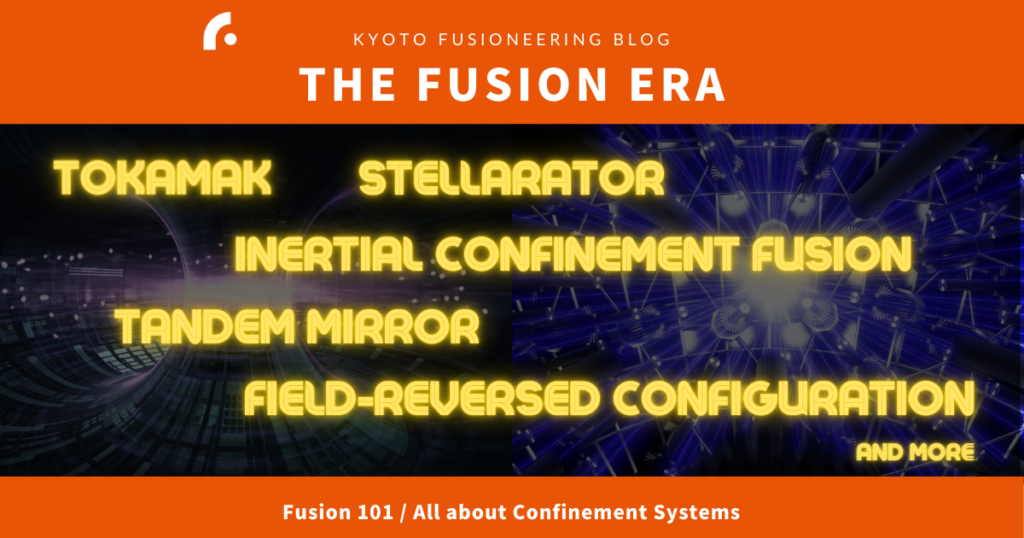
A key question in fusion is: how can the fusion reaction, the source of fusion energy that powers the Sun, be replicated on Earth? To produce this same phenomenon Earth-side, the fuel, in the form of super-heated atoms, must be heated until it reaches a plasma state. The plasma is confined in a container, and within this container, fusion reactions occur. Scientists, researchers and engineers have designed multiple types of confinement methods in their quest to harness the energy potential of fused atoms.
Within the confinement approaches, the tokamak, which uses magnets to confine the plasma, has been adopted by the ITER Project. While the tokamak has been a key confinement approach for decades, other approaches, including the stellarator/helix type, the inverse magnetic field coordination type and the mirror type, and more recently, the inertial confinement approach, are being actively developed alongside the tokamak.
Read more below to discover more about the unique confinement methods that make fusion energy possible.
1. Tokamak
Tokamak devices use a doughnut-shaped vacuum vessel to confine the plasma via a strong external magnetic field and its own current. In addition to the tokamak being used by the ITER Project, several large-scale national fusion labs, including JT60-SA in Japan and Europe, DIII-D in the US, JET in the UK and KSTAR in South Korea, use the tokamak as their main confinement method. Given its high feasibility, and the fact that several large-scale experimental units are in operation around the world, the tokamak is recognized as one of the primary confinement methods in fusion. The tokamak’s origins lie in Russia, since this technology was first developed in the Soviet Union in the 1950s at the Kurchatov Insitute in Moscow.

JT-60SA, one of the world’s largest tokamak-type experimental devices, located in Naka City, Ibaraki Pref.
Source: Towards Fusion Energy: Ministry of Education, Culture, Sports, Science and Technology
2. Stellarator
Like the tokamak, the stellarator uses a doughnut-shaped vacuum vessel, but confines the plasma using only an external magnetic field coil. Heliotrons and helicals are also types of stellarators. Princeton’s Plasma Physics Lab (PPPL) developed the world’s first stellarator in the 1950s. Currently, there are 3 major labs operating stellators: the Heliotron J (Kyoto University) and LHD (National Institute for Fusion Science) in Japan, and the Wendelstein 7-X in Germany.
Helical Fusion, a Japanese startup, is also working on developing this type of technology.

Large Helical Device (LHD) in Toki, Gifu Prefecture, Japan.
Source: Towards Fusion Energy: Ministry of Education, Culture, Sports, Science and Technology
3. Inertial Confinement Fusion (ICF)
For internal confinement, a high-energy laser is directed at a small fuel pellet, which is then heated to create a rapid high-density situation inside the pellet, triggering a fusion reaction. The fusion reaction takes place in pulses, which means that the energy supply can be adjusted based on local and regional electrical supply needs, an advantage of this approach.
The Lawrence Livermore National Laboratory, located east of San Francisco, began the first experiments on ICF in the 1960s. Two prominent startups, EX-Fusion, an Osaka University spinoff, and Blue Laser Fusion, based near Santa Barbara, CA, are developing this technology.

GEKKO XII, a large laser experimental installation in Suita, Osaka, Japan
Source: Towards Fusion Energy: Ministry of Education, Culture, Sports, Science and Technology
4. Tandem Mirrors
This method of confining plasma places a high potential structure and a magnetic field at each end of a cylindrical vacuum vessel and reflects the plasma back and forth between them using a mirror structure. The former Soviet Union and the US each actively pursued this approach from the late 70s to early 80s since it has 2 key advantages: a simpler magnetic field coil arrangement and the possibility to miniaturise the device as the technology advances.
Realta Fusion, based in Madison, WI (US), is now developing this technology. In Japan, the University of Tsukuba is home to the world’s largest tandem mirror plasma confinement system, GAMMA 10/PDX.
5. Field Reversed Configuration (FRC)
With its simple magnetic field structure, FRC confines the plasma using a poloidal magnetic field, which has the potential to increase the pressure required to confine the plasma. Currently, TAE Technologies, located south of Los Angeles, CA, and Helion, located north of Seattle, WA, are working on FRC technology development. FRC equipment is available in Japan at Nihon University and other national institutes. LINEA Innovations, a Japanese startup based in Tokyo, is working to develop the FRC method using their expertise in tandem mirrors.
More info is available by clicking on the links throughout this post and on our website.




